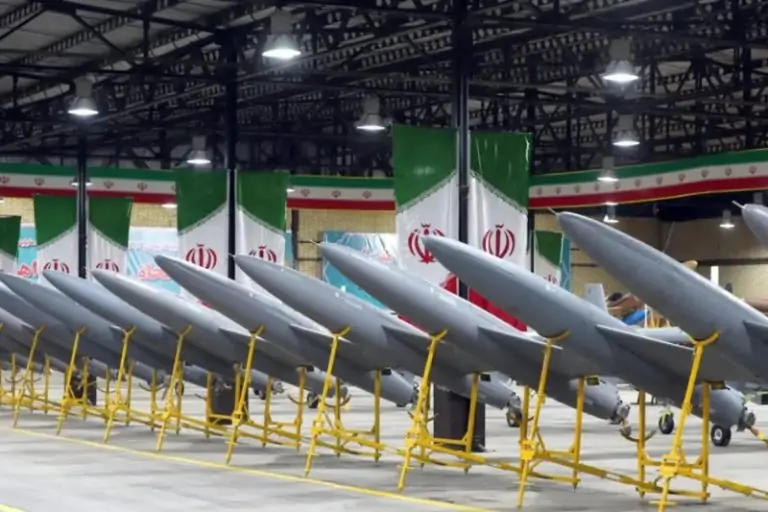

unveiling the drone dynamics irans role in escalating conflict in sudan
The conflict in Sudan takes a perilous turn as evidence surfaces of Iran supplying weaponized drones to the Sudanese Armed Forces (SAF). Recent images posted by the Rapid Support Forces (RSF) confirm the introduction of Mohajer-6 combat drones, raising concerns about the external actors influencing the ongoing struggle for control in the country.
Analysts identified the wrecked drones through images posted by the RSF on social media. The Mohajer-6, equipped to carry air-to-surface missiles and surveillance equipment, possesses a maximum speed of 200 kilometers per hour. Satellite images from Planet Labs Inc. reveal their presence at the Wadi Sayyidna air base near Khartoum, further solidifying suspicions of Iran’s direct involvement.
This revelation marks a significant escalation in the conflict, emphasizing the growing reliance of the Sudanese Armed Forces on advanced aerial weaponry. The Mohajer-6’s capabilities introduce a layer of complexity to the ongoing struggle for control between the RSF and the SAF, raising concerns about the potential for increased violence and regional destabilization.
The SAF’s visit to Iran in December, seeking deadlier drone technology, underscores the strategic efforts to regain ground lost to the RSF. The conflict, which has claimed tens of thousands of lives and displaced millions, is now at risk of transforming into a proxy war. Analysts highlight the intricate dynamics at play, with the United Arab Emirates (UAE) supplying weapons to the RSF in exchange for gold smuggled from Darfur.
This proxy war potential draws parallels with Iran’s involvement in Yemen, where it supplied drones to Houthi rebels for attacks against the UAE and Saudi Arabia. The interplay between external actors heightens concerns about regional destabilization, with Sudan at the epicenter of a geopolitical struggle that transcends its borders.
Both the RSF and SAF have incorporated drones into their military strategies, showcasing the evolving nature of modern conflict. Videos shared by the SAF depict drone attacks on RSF positions, introducing a new dimension to the already devastating impact of the conflict. The RSF, in turn, utilizes its own drones and surface-to-air missiles against SAF forces. This heightened reliance on aerial warfare intensifies the violence on the ground and raises concerns about the impact on civilian populations caught in the crossfire.
The RSF fighters, originally serving as the SAF’s ground forces under the deposed dictator Omar al-Bashir, have taken up positions in residential buildings and hospitals. This tactic has resulted in large-scale damage and loss of life from SAF attacks aimed at eliminating RSF strongholds. The civilian population bears the brunt of this conflict, with communities in Darfur heavily damaged and 11 million people displaced.
The introduction of Iranian drones adds a layer of complexity to an already intricate conflict, heightening the risk of further violence against civilian populations. The SAF’s control over key regions, including El Gezira State, becomes even more contentious as it seeks to regain ground lost to the RSF, now in control of significant portions of Darfur and southern Sudan.
The presence of Iranian-made drones in Sudan amplifies the overarching security threats in the region. As the SAF and RSF engage in an aerial arms race, the potential for spill-over violence and regional destabilization grows. The conflict, once confined to Sudan’s borders, now poses a broader risk, with neighboring countries potentially becoming entangled in the web of geopolitical rivalries.
Situated along the Red Sea, Sudan’s strategic location magnifies the impact of the conflict on regional dynamics. The RSF’s control over key regions, including Darfur and southern Sudan, has implications for Red Sea trade routes. The struggle for dominance between the RSF and SAF, now fueled by Iranian drones, could disrupt vital maritime passages, adding an economic dimension to an already complex geopolitical landscape.
The growing involvement of Iran in Sudan’s internal conflict signals its expanding presence in the region. Analysts draw parallels with Iran’s support for Houthi rebels in Yemen, where it supplied drones for attacks against neighboring countries. With Sudan now receiving advanced weaponry, there are concerns that Iran’s influence could extend beyond Sudan into northern and central Africa, creating a potential strategic foothold in the Red Sea region.
As Sudan grapples with internal strife, the conflict is no longer a localized issue but a critical aspect of the broader geopolitical puzzle. Iran’s role in supplying drones to the SAF not only deepens the complexity of the Sudanese conflict but also heightens tensions in the Red Sea region. The struggle for control over key territories now intertwines with broader geopolitical ambitions, posing a threat to regional stability.
The Sudan War Monitor’s confirmation of Iranian cargo planes landing in Sudan in late January signals a deeper level of engagement between the two nations. Sudanese officials, acting on behalf of the SAF, were quick to return to Iran for diplomatic negotiations, seeking to restore ties after a seven-year break. This diplomatic dance further complicates the geopolitical landscape, with potential repercussions extending beyond Sudan’s borders.
As tensions rise, the international community watches closely, recognizing the potential for Sudan’s internal conflict to become a battleground for broader regional rivalries. The SAF’s pursuit of deadlier drone technology from Iran underscores the lengths to which both sides are willing to go to gain an upper hand in the struggle for control.
National teams from Africa advance their World Cup qualification pursuit as they take part in Matchday 5 of the qualifiers.…
Creative Africa Nexus (CANEX) is running the Book Factory Prize for Publishing in Africa again to award $28,000 to African…
Canadian companies have expanded their presence as major African mining stakeholders and invested more than $37 billion. Africa holds the…
The South African government wants people to plant one million trees across the nation within a single day on September…
The government's statistics regulator showed that South African inflation stayed at 3.2% during February and rose below the projected 3.3%.…
Keywords: Cape Town, African Energy Chamber, Africa, The 2025 African Energy Week (AEW) will host the top energy leaders from…
This website uses cookies.